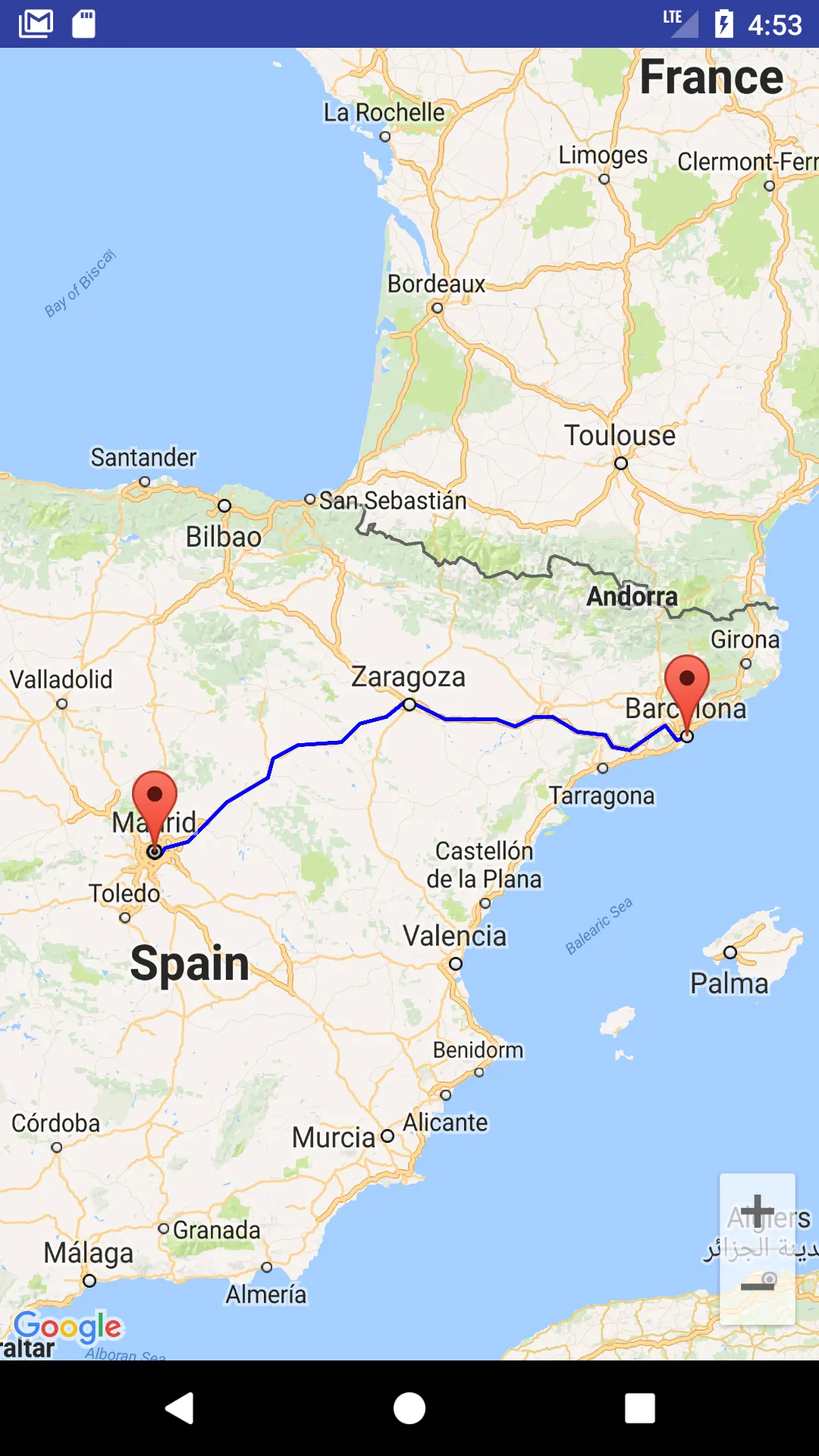请在Google控制台启用方向API。
在GetPathFromLocation.java类中替换API_KEY。
import android.graphics.Color;
import android.os.AsyncTask;
import android.util.Log;
import com.google.android.gms.maps.model.LatLng;
import com.google.android.gms.maps.model.PolylineOptions;
import org.json.JSONObject;
import java.io.BufferedReader;
import java.io.InputStream;
import java.io.InputStreamReader;
import java.net.HttpURLConnection;
import java.net.URL;
import java.util.ArrayList;
import java.util.HashMap;
import java.util.List;
public class GetPathFromLocation extends AsyncTask<String, Void, PolylineOptions> {
private String TAG = "GetPathFromLocation";
private String API_KEY = "Place_Your_API_Key";
private LatLng source, destination;
private DirectionPointListener resultCallback;
public GetPathFromLocation(LatLng source, LatLng destination, DirectionPointListener resultCallback) {
this.source = source;
this.destination = destination;
this.resultCallback = resultCallback;
}
public String getUrl(LatLng origin, LatLng dest) {
String str_origin = "origin=" + origin.latitude + "," + origin.longitude;
String str_dest = "destination=" + dest.latitude + "," + dest.longitude;
String sensor = "sensor=false";
String parameters = str_origin + "&" + str_dest + "&" + sensor;
String output = "json";
String url = "https://maps.googleapis.com/maps/api/directions/" + output + "?" + parameters + "&key=" + API_KEY;
return url;
}
@Override
protected PolylineOptions doInBackground(String... url) {
String data;
try {
InputStream inputStream = null;
HttpURLConnection connection = null;
try {
URL directionUrl = new URL(getUrl(source, destination));
connection = (HttpURLConnection) directionUrl.openConnection();
connection.connect();
inputStream = connection.getInputStream();
BufferedReader bufferedReader = new BufferedReader(new InputStreamReader(inputStream));
StringBuffer stringBuffer = new StringBuffer();
String line = "";
while ((line = bufferedReader.readLine()) != null) {
stringBuffer.append(line);
}
data = stringBuffer.toString();
bufferedReader.close();
} catch (Exception e) {
Log.e(TAG, "Exception : " + e.toString());
return null;
} finally {
inputStream.close();
connection.disconnect();
}
Log.e(TAG, "Background Task data : " + data);
JSONObject jsonObject;
List<List<HashMap<String, String>>> routes = null;
try {
jsonObject = new JSONObject(data);
DirectionHelper helper = new DirectionHelper();
routes = helper.parse(jsonObject);
Log.e(TAG, "Executing Routes : ");
ArrayList<LatLng> points;
PolylineOptions lineOptions = null;
for (int i = 0; i < routes.size(); i++) {
points = new ArrayList<>();
lineOptions = new PolylineOptions();
List<HashMap<String, String>> path = routes.get(i);
for (int j = 0; j < path.size(); j++) {
HashMap<String, String> point = path.get(j);
double lat = Double.parseDouble(point.get("lat"));
double lng = Double.parseDouble(point.get("lng"));
LatLng position = new LatLng(lat, lng);
points.add(position);
}
lineOptions.addAll(points);
lineOptions.width(10);
lineOptions.color(Color.BLUE);
Log.e(TAG, "PolylineOptions Decoded");
}
if (lineOptions != null) {
return lineOptions;
} else {
return null;
}
} catch (Exception e) {
Log.e(TAG, "Exception in Executing Routes : " + e.toString());
return null;
}
} catch (Exception e) {
Log.e(TAG, "Background Task Exception : " + e.toString());
return null;
}
}
@Override
protected void onPostExecute(PolylineOptions polylineOptions) {
super.onPostExecute(polylineOptions);
if (resultCallback != null && polylineOptions != null)
resultCallback.onPath(polylineOptions);
}
}
DirectionHelper.java
import com.google.android.gms.maps.model.LatLng;
import org.json.JSONArray;
import org.json.JSONException;
import org.json.JSONObject;
import java.util.ArrayList;
import java.util.HashMap;
import java.util.List;
public class DirectionHelper {
public List<List<HashMap<String, String>>> parse(JSONObject jObject) {
List<List<HashMap<String, String>>> routes = new ArrayList<>();
JSONArray jRoutes;
JSONArray jLegs;
JSONArray jSteps;
try {
jRoutes = jObject.getJSONArray("routes");
for (int i = 0; i < jRoutes.length(); i++) {
jLegs = ((JSONObject) jRoutes.get(i)).getJSONArray("legs");
List path = new ArrayList<>();
for (int j = 0; j < jLegs.length(); j++) {
jSteps = ((JSONObject) jLegs.get(j)).getJSONArray("steps");
for (int k = 0; k < jSteps.length(); k++) {
String polyline = "";
polyline = (String) ((JSONObject) ((JSONObject) jSteps.get(k)).get("polyline")).get("points");
List<LatLng> list = decodePoly(polyline);
for (int l = 0; l < list.size(); l++) {
HashMap<String, String> hm = new HashMap<>();
hm.put("lat", Double.toString((list.get(l)).latitude));
hm.put("lng", Double.toString((list.get(l)).longitude));
path.add(hm);
}
}
routes.add(path);
}
}
} catch (JSONException e) {
e.printStackTrace();
} catch (Exception e) {
}
return routes;
}
private List<LatLng> decodePoly(String encoded) {
List<LatLng> poly = new ArrayList<>();
int index = 0, len = encoded.length();
int lat = 0, lng = 0;
while (index < len) {
int b, shift = 0, result = 0;
do {
b = encoded.charAt(index++) - 63;
result |= (b & 0x1f) << shift;
shift += 5;
} while (b >= 0x20);
int dlat = ((result & 1) != 0 ? ~(result >> 1) : (result >> 1));
lat += dlat;
shift = 0;
result = 0;
do {
b = encoded.charAt(index++) - 63;
result |= (b & 0x1f) << shift;
shift += 5;
} while (b >= 0x20);
int dlng = ((result & 1) != 0 ? ~(result >> 1) : (result >> 1));
lng += dlng;
LatLng p = new LatLng((((double) lat / 1E5)),
(((double) lng / 1E5)));
poly.add(p);
}
return poly;
}
}
DirectionPointListener.java
import com.google.android.gms.maps.model.PolylineOptions;
public interface DirectionPointListener {
public void onPath(PolylineOptions polyLine);
}
在Activity或Fragment中使用
LatLng source = new LatLng(xx.xxxx, yy.yyyy);
LatLng destination = new LatLng(xx.xxxx, yy.yyyy);
new GetPathFromLocation(source, destination, new DirectionPointListener() {
@Override
public void onPath(PolylineOptions polyLine) {
yourMap.addPolyline(polyLine);
}
}).execute();
